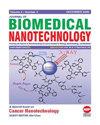Effect of Piezo1 Channel-Mediated Mechanotransduction on Osteogenic Differentiation and Interleukin-6 Secretion in Bone Mesenchymal Stem Cells Under Tensile Strain
IF 2.9
4区 医学
Q1 Medicine
引用次数: 0
Abstract
Physical stimulation plays a crucial role in the osteogenic differentiation of bone marrow-derived mesenchymal stem cells (MSCs). However, the mechanotransductive mechanisms remain uncleared. Recent studies have suggested that the Piezo1 channel is essential for transforming mechanical signals. Therefore, we investigate the Piezo1-mediated mechanisms in mechanical strain-regulated MSC osteogenic differentiation and release of proinflammatory cytokines. The tensile strain was applied to rat MSCs cultured in a monolayer to induce mechanical strain. The immuno-nanomagnetic bead enzyme-linked immunosorbent assay was employed to assess gene and protein expressions, as well as osteogenic biomarkers and interleukin-6 (IL-6) release, both in the presence or absence of a Piezo1 agonist/antagonist. Firstly, biophysical loading through mechanical strain was found to promote MSC osteogenic differentiation. Suppression of Piezo1 using GsMTx4 antagonist or transfection with Piezo1-siRNA effectively inhibited mechanical responses associated with osteogenic gene expressions and IL-6. Activation of Piezo1 by Yoda1 mimicked the effects induced by mechanical strain on osteogenic gene expressions and IL-6 release, which were associated with YAP activation, upregulation, and nuclear accumulation of β-catenin. In conclusion, these findings significantly enhance our understanding of MSC mechanotransduction and hold great promise for drug development to enhance skeletal mass.Piezo1 通道介导的机械传导对拉伸应变下骨间质干细胞成骨分化和白细胞介素-6 分泌的影响
物理刺激在骨髓间充质干细胞的成骨分化过程中起着至关重要的作用。然而,机械传导机制仍不清楚。最近的研究表明,Piezo1 通道是转化机械信号的关键。因此,我们研究了Piezo1介导的机械应变调节间充质干细胞成骨分化和释放促炎细胞因子的机制。对单层培养的大鼠间充质干细胞施加拉伸应变以诱导机械应变。采用免疫纳米磁珠酶联免疫吸附试验来评估基因和蛋白质的表达,以及成骨生物标志物和白细胞介素-6(IL-6)的释放。首先,通过机械应变进行生物物理加载可促进间充质干细胞成骨分化。使用 GsMTx4 拮抗剂抑制 Piezo1 或转染 Piezo1-siRNA 能有效抑制与成骨基因表达和 IL-6 相关的机械反应。Yoda1对Piezo1的激活模拟了机械应变对成骨基因表达和IL-6释放的影响,这些影响与YAP的激活、上调和β-catenin的核积累有关。总之,这些发现极大地促进了我们对间叶干细胞机械传导的了解,并为提高骨骼质量的药物开发带来了巨大希望。
本文章由计算机程序翻译,如有差异,请以英文原文为准。
求助全文
约1分钟内获得全文
求助全文
来源期刊
CiteScore
4.30
自引率
17.20%
发文量
145
审稿时长
2.3 months
期刊介绍:
Information not localized
文献相关原料
| 公司名称 | 产品信息 | 采购帮参考价格 |
|---|

 求助内容:
求助内容: 应助结果提醒方式:
应助结果提醒方式:


